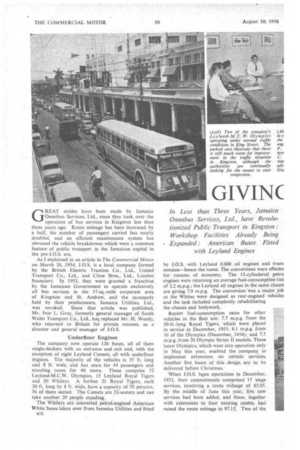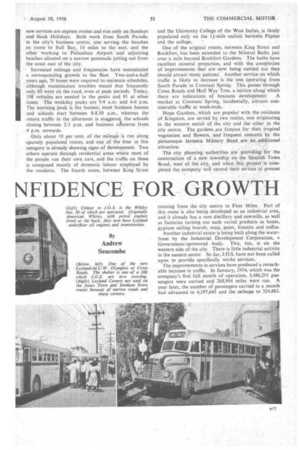GIVINC
Page 50

Page 51

Page 52

If you've noticed an error in this article please click here to report it so we can fix it.
NIFIDENCE FOR GROWTH
In Less than Three Years, Jamaica Omnibus Services, Ltd., have Revolutionized Public Transport in Kingston : Workshop Facilities Already Being Expanded : American Buses.Fitted
with Leyland Engines
By
Andrew Seacombe
GREAT strides have been made by Jamaica Omnibus Services, Ltd., since they took over the operation of bus services in Kingston less than three years ago. Route mileage has been increased by a half, the number of passengers carried has nearly doubled, and an efficient maintenance system has obviated the vehicle breakdowns which were a common feature of public transport in the Jamaican capital in the pre-J.O.S. era.
As I explained in an article in The Commercial Motor on March 26, .1954, J.Q.S. is a local company formed by the British Electric Traction Co., Ltd., United Transport Co., Ltd., and Close Bros., Ltd., London financiers. In 1953, they were granted a franchise by the Jamaican Government to operate exclusively all bus services in the 37-sq.-mile corporate area of Kingston and St. Andrew, and the monopoly held by their predecessors, Jamaica Utilities, Ltd., was revoked. Since that article was published, Mr. Ivor L. Gray, formerly general manager of South Wales Transport Co., Ltd., ha replaced Mr. H. Weedy, who returned to Britain for private reasons, as a director and general manager of J.O.S.
Underfloor Engines The company now operate 126 buses, all of them single-deckers with an entrance and exit and, with the exception of eight Leyland Comets, all with underfloor engines. The majority of the vehicles is 35 ft. long and 8 ft. wide, and has seats for 44 passengers and standing room for 40 more. These comprise 52 Leyland-M.C.W. Olympics, 15 Leyland Royal Tigers and 30 Whileys, A further 21 Royal Tigers, each 30 ft, long by 8 ft. wide, have a capacity of 70 persons, 36 of them seated. The Comets are 32-seaters and can take another 20 people standing..
The Whileys are converted petrol-engined .American White buses taken over from Jamaica Utilities and fitted al 6
by 1.0.5. with Leyland 0.600 oil engines and trans. mission—hence the name. The conversions were effectec for reasons of economy. The 12-cylindered petro engines were returning an average fuel-consumption rat( of 2.2 m.p.g.; the Leyland oil engines in the same chassi: are giving 7.9 m.p.g. The conversion was a major job as the Whites were designed as rear-engined vehicles and the task included completely rehabilitating the chassis and bodywork.
Recent fuel-consumption rates for other vehicles in the fleet are: 7.7 m.p.g. from the 30-ft.-long Royal Tigers," which were placed in service in December, 1953; 8.1 m.p.g. from 10 of the Olympics (December, 1954); and 73 m.p.g. from 20 Olympic Series II models. These latest Olympics, which went into operation only in May this year, enabled the company to implement extensions on certain . services. Another five buses of this design are to be delivered before Christmas.
When I.O.S. bgan operations in December, 1953, their commitments comprised 15 stage services, involving a route mileage of 65.05. By the middle of June this year, five new services had been added, . and these, together with extensions to four existing routes, had -raised the route mileage to 97.1. Two of the
new services are express routes and run only on Sundays and Bank Holidays. Both work from South Parade, in the city's business centre, one serving the beaches en route to Bull Bay, 10 miles to the east, and the other working to Palisadoes Airport and adjoining beaches situated on a narrow peninsula jutting out from the coast east of the city.
Increased mileage. and frequencies have necessitated a corresponding growth in the fleet: Two-and-a-half years ago, 70 buses were required to maintain schedules, although maintenance troubles meant that frequently only 60 were on the road, even at peak periods. Today, 108 vehicles are needed in the peaks and 81 at other Limes. The weekday peaks are 59 a.m. and 4-6 p.m. Che morning peak is the busiest; Most business houses and schools start between 8-8.30 a.m., whereas the return traffic in the afternoon is staggered, the schools closing between 2-3 p.m. and business concerns from 4p.m. onwards.
Only about 10 per cent, of the mileage is run along sparsely populated routes, and one of the four in this category is already showing signs of development. Two others operate through residential areas. where most of the people run their own cars, and the traffic on these is composed mainly of domestic labour employed by the residents. The fourth route, between King Street
and the University College of the West Indies, is thinly populated only on the 11-mile seetion betWeen Papine and the college.
One of the original routes, between King Street and ROckfort, has been extended to the Mineral Baths just over a mile beyond Rockfort Gardens. The baths have excellent mineral properties, and with the completion -of improvements that are now being carried out they should attract many patrons: Another service on which traffic is likely to increase is the one operating from South Parade to Constant Spring. This passes through Cross Roads and Half Way Tree, a section along which
• there are indications of business development. A market at Constant Spring, incidentally, attracts considerable traffic at week-ends.
Hope Gardens, which are popular with the residents of Kingston, are served by two 'routes, one originating -in the western sector' of the city and the other in the city centre. The gardens Are famous for their tropical vegetation and flowers, and frequent concerts by the picturesque Jamaica Military Band are an additional attraction.
The city planning authorities are .providing for the construction of .a new township on the Spanish Town Road, west of the city, and when this project is completed the company will extend their service at present
running from the city centre to Four Miles. Part of this route is also being developed as an industrial area, and it already has a rum distillery and sawmills, as well as factories turning out such varied products as box'es, gypsum ceiling boards, soap, paint, biscuits and coffee.
Another industrial estate is being built along the waterfront by the Industrial Development Corporation, a Government-sponsored body. • This, too, is on the western side of the city. There is little industrial activity in the eastern sector. So far, J.O.S. have not been called upon to provide specifically works services.
The improvements in services have produced a remarkable increase in traffic. In January, 1954, which was the company's first full month of operation, 3,486,291 passengers were carried and 268,994 miles were run. A year later, the number of passengers carried in a month had advanced to 4,197,645 and the mileage to 324.883_ In May this year, there were 5,052,304 passengers, the fleet covering 376;116 miles. Since then there has been a further increase of about 10 per cent.
Most services still operate from their original terminal points in the city centre, although there have been a few minor alterations which have had the effect of easing traffic congestion., Traffic conditions have improved since my last report. A one-way system has been introduced in many of the streets, and hand carts and mule drays have been prohibited fromusing certain main thoroughfares in the peaks.
Delays are still frequent, particularly at points where the north to south traffic meets that running from east to west-, but it is significant that buses on most of the services have slightly increased their journey speeds since December, 1953. The average timetable speed for all routes has advanced from 8.7 m.p.h. to 10 m.p.h. Bus stops are provided at the rate of approximately six to the mile.
Roads are generally good.. Most of the company's operating territory is flat, but there are steady climbs on two routes,_ one to a height of 600 ft. (to Constant Spring), and the other to 500 ft. (to Papine, via Cross Roads).
Already the company are expanding their extensive facilities to meet the maintenance demands of the growing fleet. At present, the depot occupies about four acres of a 10-acre site at Industrial Terrace on the foreshore road. The main buildings comprise an office block, the workshops, and auxiliary offices together with a canteen, cloakrooms with showers, tyre repair shop and lubricating oil stores_ The well-equipped workshop building is divided into five sections. Ancillary shops are located adjacent to, and open on, the main Workshop. There are at present six pits for maintenance work, and another four are to be sunk under the expansion plans. Adjoining the pits are the body and paint shops, each of which is designed to house two vehicles. Extra accommodation for this work is also to be provided. The general store has some 5,500 items, the abnormally high stock being necessary because of delays in delivery of parts consequent on the distance from manufacturers.
Maintenance is on a mileage basis, the first (A) dock being carried out after 6,250 miles, and the second (B) s18 at between 50,000 and 100,000-miles. A third (C) dock is planned for 150,000 miles, but if this is found to be unnecessary the B dock will be advanced to this mileage and the C overhaul will be put forward to 200,000 miles. The only major attention given to the first of the engines so far to approach 150,000 miles has been decarbonizing and valve grinding.
The docks are thorough; the first covering 96 items •
and the second 97. The principal difference between the two is that at the B overhaul, cylinder, heads, fuel pumps, shock absorbers, starters and generators are changed.
There is also a fortnightly inspection, of each vehicle, particular attention being given to brakes and steering.
Rapid deterioration because of climatic conditions makes it necessary to spray the exterior of the buses every 12 months. For the same reason, the outside metal sheeting of the bodies often becomes, v jsible. • Rotting of timber in floors and steps, is also attributed to the climate. Door rubber facings have also worn quickly, this being caused by passengers moistening the rubber with perspiration when boarding thevehicles.
Tyre wear is heavy owing to high temperatures. During a recent three-monthly period, the 11.00-20-in, tyres fitted on most of the buses covered an average of 23,500 miles. Retreaded 11.00-20-in.
covers are giving 19,700 miles, Some covers have had three retreads, and the majority is retreaded twice.
More than 700 people are employed by the company. All the drivers and conductors are Jamaicans. For a 48-hour week, drivers are paid £6 8s., conductors (male and female) receiving £5. Although many of the staff have left to come to England, there is no shortage of applicants for jobs in either category. Diffi culties are, however, experienced in selecting and training suitable persons, particularly for driving.
" Successful applicants for driving vacancies are given a five-day course of instruction on the buses before passing a final test. This has been found necessary because drivers new to.the company have not previously had the opportunity of driving the type of vehicle they operate. Conductors undergo a 12-day course of tuition, comprising lectures and practical training with experienced staff.
That the people of Kingston are completely satisfied with this, to them, new standard of service in public transport is shown in the words of two representative citizens. Mr. Leacroft Robinson, chairman of the Public Passenger Transport (Corporate Area) Board of Control (the equivalent of our Licensing Authorities), recently wrote to J.O.S.: "My board has directed me to convey their appreciation for your successful efforts ia improving the services in general."
Congratulating the company on the "continuing: forward steps" being taken by them, to improve the bus services, Mr. Alec Dune, a prominent Jamaica businessman and vice-chairman of the Chamber of Commerce, wrote: "The new routes you have taken on set the pattern of confidence for the growth of the city."




































































































